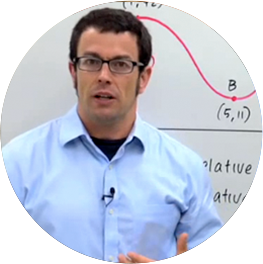Unit
Vectors and Parametric Equations

Cornell University
PhD. in Mathematics
Norm was 4th at the 2004 USA Weightlifting Nationals! He still trains and competes occasionally, despite his busy schedule.
To unlock all 5,300 videos, start your free trial.

Cornell University
PhD. in Mathematics
Norm was 4th at the 2004 USA Weightlifting Nationals! He still trains and competes occasionally, despite his busy schedule.
One application of parametric equations that is useful to learn is how to parameterize a circle. In order to parameterize a circle centered at the origin, oriented counter-clockwise, all we need to know is the radius. In order to understand how toparameterize a circle, it is necessary to understandparametric equations, and it can be useful to learn how to parameterize other figures, such asline segments.
I want to talk about finding the parametric equations for a circle. Let's start by looking back at the unit circle. Remember the unit circle definitions of cosine and sine we drew a unit circle which is the circle x squared plus y squared equals 1 it's centered at the origin and it has got radius 1. Now if we make theta the angle between the positive x axis and the terminal side then the x and y coordinates of this point on the terminal side are going to be your cosine and sine so those are the unit circle definitions of cosine and sine. But they suggest a parameterization of the unit circle x equals cosine theta and y equals sine theta and of course you can get the entire circle just by having theta go from 0 to 2 pi.
You can have it do more but this is enough. Now let's see what kind of parameterization that gives us. When theta equals 0 remember that we're going to be right here, when theta equals pi we'll be up here. What this tells us is that as theta advances we're going around the circle counter clockwise we'll be here at pi, here at 3 pi over 2 and back here again at 2 pi. So the direction of the parameterization is counter clockwise that's important. We'll talk about clockwise parameterizations a little bit later. Now let's talk about a parameterization of x squared plus y squared equals r squared so it's also a circle but this time the radius is r, very similar all you have to do is x equals r cosine theta and y equals r sine theta same restriction you at least need theta to go from 0 to 2 pi and again this will be a counter clockwise parameterization of the circle with radius r starting at that right hand point r0, so starting right there.
